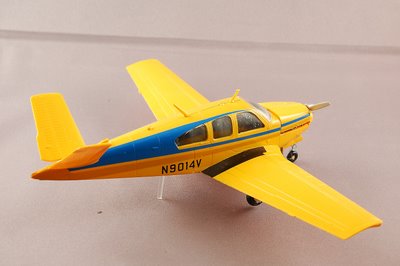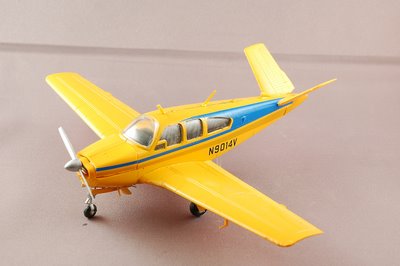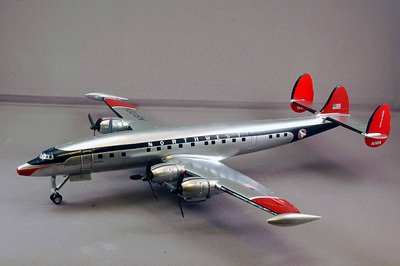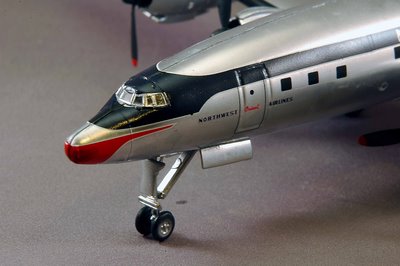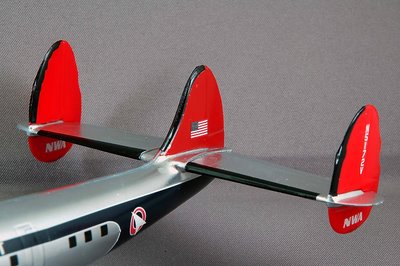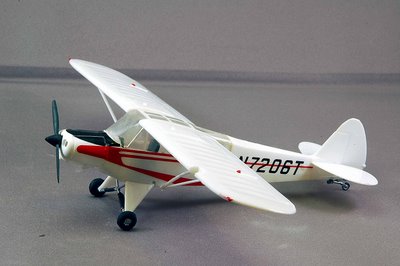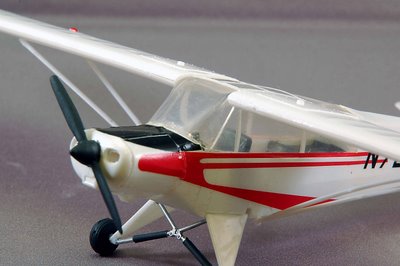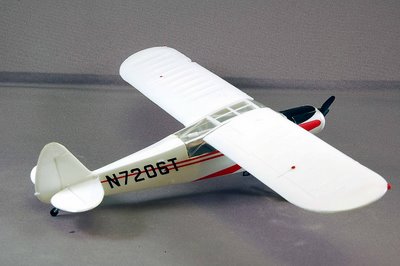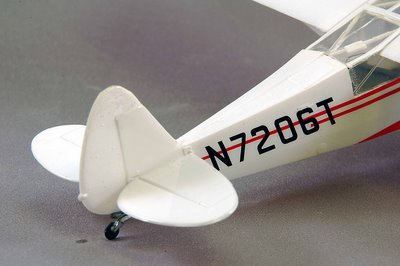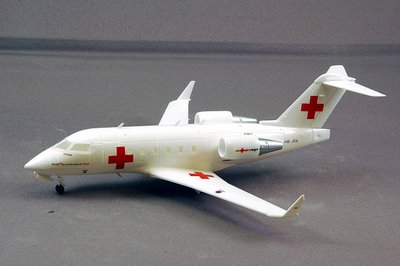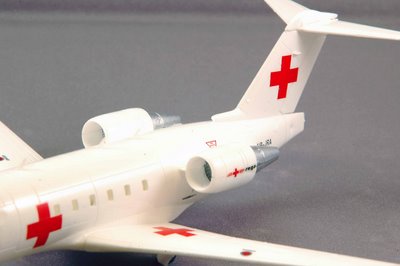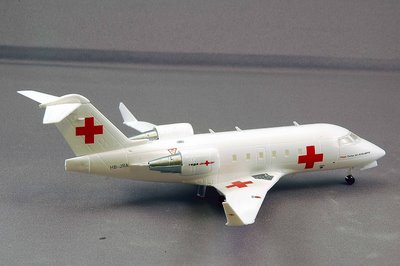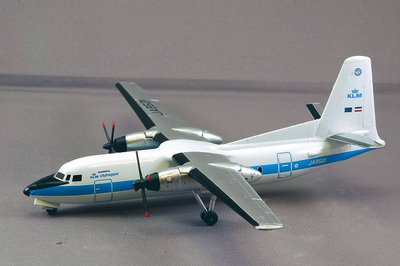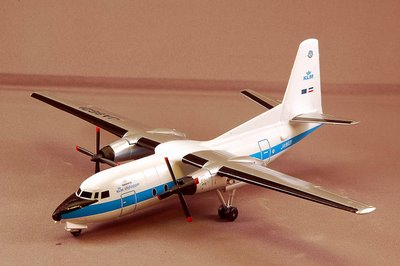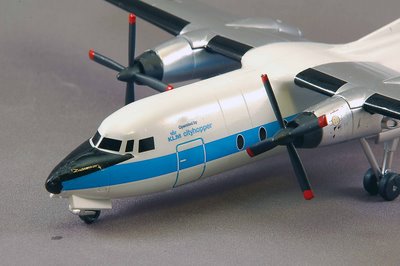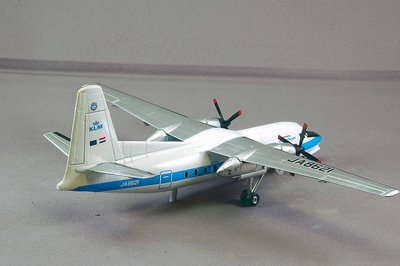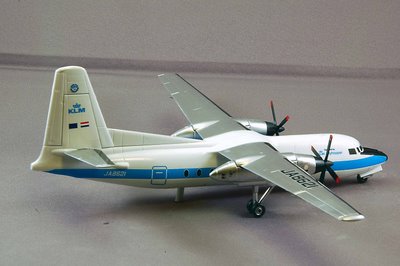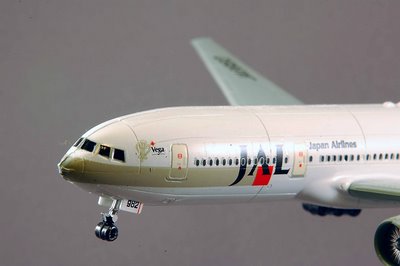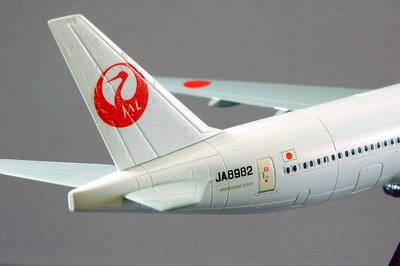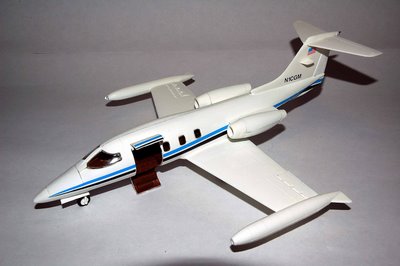Sunday, December 03, 2006
Minicraft Beechcraft Bonanza V35A 1/48 Scale
Sporting a distinctive V-shaped or “butterfly” tail, the Beechcraft Bonanza set the standard for the stylish yet well-equipped aircraft for the private pilot, albeit one who could afford to fly in relative luxury. Since its introduction in 1947, the Bonanza has been admired as a “classic” in the aviation world, even earning Fortune magazine's prestigious award in 1959 as one of the 100 best designed mass-production products.
The Beech Aircraft Corporation, confident in its manufacturing capacity after building more than 7,000 combat aircraft during World War II, positioned itself for the post-war era by designing a revolutionary single-engine aircraft with a V-tail configuration that trimmed weight without compromising control. Company founder Walter Beech envisioned a light aircraft with a level of performance and comfort that would distinguish it from the competition.
In theory, the Bonanza's V-tail design uses only two surfaces to perform its function as compared to the three surfaces of a conventional straight-tail design. This reduction in surfaces reduces both drag and weight, while also lowering the probability of tail buffeting from the wakes generated by the aircraft's wing and canopy. Aircraft control response with the V-tail is equivalent to that of a conventional tail of 40 percent greater surface area. Manufacturing costs for the V-tail design are also lower because fewer parts are required to fabricate only two surfaces instead of three.
Model Kit Review:
http://www.abcmodelsport.net/p350300/Minicraft-1609-148-Beech-Bonanza.html
Other information:
http://www.pilotfriend.com/aircraft%20performance/Beech/bonanza.htm
http://www.centennialofflight.gov/essay/GENERAL_AVIATION/bonanza/GA10.htm
http://en.wikipedia.org/wiki/Beechcraft_Bonanza
http://www1.airliners.net/info/stats.main?id=324
The Beech Aircraft Corporation, confident in its manufacturing capacity after building more than 7,000 combat aircraft during World War II, positioned itself for the post-war era by designing a revolutionary single-engine aircraft with a V-tail configuration that trimmed weight without compromising control. Company founder Walter Beech envisioned a light aircraft with a level of performance and comfort that would distinguish it from the competition.
In theory, the Bonanza's V-tail design uses only two surfaces to perform its function as compared to the three surfaces of a conventional straight-tail design. This reduction in surfaces reduces both drag and weight, while also lowering the probability of tail buffeting from the wakes generated by the aircraft's wing and canopy. Aircraft control response with the V-tail is equivalent to that of a conventional tail of 40 percent greater surface area. Manufacturing costs for the V-tail design are also lower because fewer parts are required to fabricate only two surfaces instead of three.
Model Kit Review:
http://www.abcmodelsport.net/p350300/Minicraft-1609-148-Beech-Bonanza.html
Other information:
http://www.pilotfriend.com/aircraft%20performance/Beech/bonanza.htm
http://www.centennialofflight.gov/essay/GENERAL_AVIATION/bonanza/GA10.htm
http://en.wikipedia.org/wiki/Beechcraft_Bonanza
http://www1.airliners.net/info/stats.main?id=324
Friday, December 01, 2006
Minicraft Lockheed 1049G Super Constellation 1/144 Scale
Constellation L-49 / L-649 / L-749The Lockheed Constellation L-49 was developed in the beginning of the 40's. Pan Am and TWA had made appropriate demands for a 40 seat passenger airplane. World War II gave the L-49, which had completed 1943 their first flight, however immediately a military career (among other things as Rosinen Bomber). 1945 became the Constellation for the civilian service certified. It was called now L-649 and offered to 48 to 81 passengers place, if the seats closely adjusted.
Super Constellation L-1049End of the 40's the air traffic grow rapid and the airlines wished larger airplanes. Thus 1950 those anyway long Constellation was stretched for super by 5.60 meters to the Constellation L-1049. This aspect ratio stressed the swung dolphin line of the Constellation and makes the Superconny. The charismatic airplane of the 50's. It offered place even 109 passengers up to 95, and was sold altogether in 254 copies .
Starliner L-1649Finally passengers and airlines required for larger ranges. Douglas with the DC-7c had set a new yardstick here. Lockheed reacted 1956 with a advancement of the Constellation. The airplane received a completely again designed wing unit with larger span and a larger fuel plant. The model with the designation L-1649 became as super star Constellation or - more usually - than star liner. 43 star liners were sold.
Monogram Model Kit Review:
http://www.modelingmadness.com/scotts/korean/m121preview.htm
Other information:
http://en.wikipedia.org/wiki/Lockheed_Constellation
http://www.aviation-history.com/lockheed/1049.html
Super Constellation L-1049End of the 40's the air traffic grow rapid and the airlines wished larger airplanes. Thus 1950 those anyway long Constellation was stretched for super by 5.60 meters to the Constellation L-1049. This aspect ratio stressed the swung dolphin line of the Constellation and makes the Superconny. The charismatic airplane of the 50's. It offered place even 109 passengers up to 95, and was sold altogether in 254 copies .
Starliner L-1649Finally passengers and airlines required for larger ranges. Douglas with the DC-7c had set a new yardstick here. Lockheed reacted 1956 with a advancement of the Constellation. The airplane received a completely again designed wing unit with larger span and a larger fuel plant. The model with the designation L-1649 became as super star Constellation or - more usually - than star liner. 43 star liners were sold.
Monogram Model Kit Review:
http://www.modelingmadness.com/scotts/korean/m121preview.htm
Other information:
http://en.wikipedia.org/wiki/Lockheed_Constellation
http://www.aviation-history.com/lockheed/1049.html
Minicraft Piper Super Cub PA 18 1/48 Scale
The Super Cub is one of Piper's most successful and long lived aircraft programs, with production spanning over four decades. The PA-18 Super Cub was the ultimate development of Piper's original aircraft, the J-3 Cub (described separately). The four seat development of the Cub, the PA-14 Family Cruiser, was the basis for the Super Cub, but the later differed in having seating for two in tandem (as on the Cub), all metal wings and, in its initial form, a 65kW (90hp) Continental C-90 in the PA-18-90 or a 80kW (108hp) Lycoming O-235 engine in the PA-18-105.
The Super Cub flew for the first time in 1949, and certification was awarded on November 18 that year. The first production Super Cubs were delivered from late 1949, the type replacing the PA-11 Cub Special on Piper's production lines.
Model Kit Review:
http://modelingmadness.com/scotts/civil/scubpreview.htm
The Super Cub flew for the first time in 1949, and certification was awarded on November 18 that year. The first production Super Cubs were delivered from late 1949, the type replacing the PA-11 Cub Special on Piper's production lines.
Model Kit Review:
http://modelingmadness.com/scotts/civil/scubpreview.htm
Revell Bombardier Challenger CL 604 1/144 Scale
Originating from the drawing board of Bill Lear, designer of the Lear Jet, this executive jet was first named Learstar 600. However when Lear sold the executive production rights to Canadair in April 1976, the type was redesignated as the Canadair CL.600 and became known subsequently as the Challenger.
Canadair’s market research indicated a sales potential for some 1000 business aircraft in this category and believing it could capture 40% of this market, the company launched the Challenger development programme on 29th October 1976, at which time it had 53 firm orders and a $130 million Canadian government loan.
Canadair introduced a number of changes in the basic design, the most noticeable being the movement of the tailplane from the bottom of the tail to the top. A major selling point for the Challenger is a fuselage of large cross section with a width of 2.49m and height of 1.85m, providing a “walk about” cabin not present in any other business jet. The aircraft provides comfortable accommodation for a maximum of 18 passengers.
Three pre-production aircraft were built, the first of them flying on 8th November 1978 with the power plant of two Lycoming ALF502L-2 turbofan engines each rated at 7500 lb st (33.35kN). The first production aircraft flew on 21st September 1979 after which Canadian and US certification was gained during late 1980.
By 1982 Canadair had firm orders and options for 200 aircraft. Out of those 150 were for the CL.600 and the remainder for the CL.601. By the middle of the 1990’s deliveries had exceeded 300 with sales of subsequent models increasing.
The CL.604 first flew on 18th September 1984 and delivered from 1996. Engines were uprated to two CF34-3B each rated at 8730 lb st (38.83kN) and fuel capacity extended to 1242 litres for a range of 7408km. Other changes included new landing gear, strengthened tail unit and a Collins electronic flight instrumentation system.
Revell Model Review:
http://www.fortunecity.com/meltingpot/portland/971/Reviews/70s/cl-604_swissair_144.htm
Canadair’s market research indicated a sales potential for some 1000 business aircraft in this category and believing it could capture 40% of this market, the company launched the Challenger development programme on 29th October 1976, at which time it had 53 firm orders and a $130 million Canadian government loan.
Canadair introduced a number of changes in the basic design, the most noticeable being the movement of the tailplane from the bottom of the tail to the top. A major selling point for the Challenger is a fuselage of large cross section with a width of 2.49m and height of 1.85m, providing a “walk about” cabin not present in any other business jet. The aircraft provides comfortable accommodation for a maximum of 18 passengers.
Three pre-production aircraft were built, the first of them flying on 8th November 1978 with the power plant of two Lycoming ALF502L-2 turbofan engines each rated at 7500 lb st (33.35kN). The first production aircraft flew on 21st September 1979 after which Canadian and US certification was gained during late 1980.
By 1982 Canadair had firm orders and options for 200 aircraft. Out of those 150 were for the CL.600 and the remainder for the CL.601. By the middle of the 1990’s deliveries had exceeded 300 with sales of subsequent models increasing.
The CL.604 first flew on 18th September 1984 and delivered from 1996. Engines were uprated to two CF34-3B each rated at 8730 lb st (38.83kN) and fuel capacity extended to 1242 litres for a range of 7408km. Other changes included new landing gear, strengthened tail unit and a Collins electronic flight instrumentation system.
Revell Model Review:
http://www.fortunecity.com/meltingpot/portland/971/Reviews/70s/cl-604_swissair_144.htm
Doyusha Fokker F27 Friendship ANA 1/144 Scale
Design of the Fokker F27 started in the 1950s as a replacement to the successful DC-3 airliner. The manufacturer evaluated a number of different configurations before finally deciding on a high wing twin Rolls-Royce Dart engined layout with a pressurised cabin for 28 passengers.
The first prototype, registered PH-NIV, first flew on 24 November 1955. The second prototype and initial production machines were 3 ft (0.9 m) longer, addressing the first aircraft's slightly tail-heavy handling and also providing space for more passengers. These aircraft also used the more powerful Dart Mk 528 engine.
In 1956 Fokker signed a licensing deal with the US aircraft manufacturer Fairchild for the latter to construct the aircraft in the USA. The first U.S.-built aircraft flew on 12 April 1958. As at the end of the Fokker F27s production, 786 units had been built (including 206 in the USA by Fairchild), which makes it the most successful turboprop airliner of all time.
In the early 1980s, Fokker developed a successor to the Friendship, the Fokker F50, with upgraded engines and systems.
Doyusha Model Review:
Type: injection New model : yes, 4th quarter 1998 Suited for: beginners Number of parts: 18 Accuracy: credible Looks like: ... a real F-27 This model is available since the end of 1998 and results in a nice small model the Fokker F-27 Friendship, the most built post-WW2 commuter type aircraft in its class. The model can be built quite easy, and goes together without any problems. As is often seen in this scale, windows are represented by decals, which can be a problem if you prefer building a slightly different version for a different airline.
Fortunately, Doyusha have included registration numbers for the entire All Nippon F-27 fleet. I finished my kit as JA8621, which was operated by All Nippon Airways and later also by the dutch Limburg Airlines and finally by Air Anglia of the UK (incidently: this airframe once suffered a nose gear collapse during take off at Schiphol). Conclusion: This model is nice to build and seems to be a real F-27 when ready. It is quite small however in this scale, and can be nicely portrayed next to the derived modernized Fokker 50 of Welsh in the same scale.
Other information:
http://www1.airliners.net/info/stats.main?id=217
http://www.answers.com/topic/fokker-f27
http://www.flightlevel350.com/Fokker-27_aircraft_facts.html
The first prototype, registered PH-NIV, first flew on 24 November 1955. The second prototype and initial production machines were 3 ft (0.9 m) longer, addressing the first aircraft's slightly tail-heavy handling and also providing space for more passengers. These aircraft also used the more powerful Dart Mk 528 engine.
In 1956 Fokker signed a licensing deal with the US aircraft manufacturer Fairchild for the latter to construct the aircraft in the USA. The first U.S.-built aircraft flew on 12 April 1958. As at the end of the Fokker F27s production, 786 units had been built (including 206 in the USA by Fairchild), which makes it the most successful turboprop airliner of all time.
In the early 1980s, Fokker developed a successor to the Friendship, the Fokker F50, with upgraded engines and systems.
Doyusha Model Review:
Type: injection New model : yes, 4th quarter 1998 Suited for: beginners Number of parts: 18 Accuracy: credible Looks like: ... a real F-27 This model is available since the end of 1998 and results in a nice small model the Fokker F-27 Friendship, the most built post-WW2 commuter type aircraft in its class. The model can be built quite easy, and goes together without any problems. As is often seen in this scale, windows are represented by decals, which can be a problem if you prefer building a slightly different version for a different airline.
Fortunately, Doyusha have included registration numbers for the entire All Nippon F-27 fleet. I finished my kit as JA8621, which was operated by All Nippon Airways and later also by the dutch Limburg Airlines and finally by Air Anglia of the UK (incidently: this airframe once suffered a nose gear collapse during take off at Schiphol). Conclusion: This model is nice to build and seems to be a real F-27 when ready. It is quite small however in this scale, and can be nicely portrayed next to the derived modernized Fokker 50 of Welsh in the same scale.
Other information:
http://www1.airliners.net/info/stats.main?id=217
http://www.answers.com/topic/fokker-f27
http://www.flightlevel350.com/Fokker-27_aircraft_facts.html
Doyusha Boeing 777-200 1/200 Scale
The Model 777, the first entirely new Boeing airplane in more than a decade, was the first jetliner to be 100 percent digitally designed using three-dimensional computer graphics. Throughout the design process, the airplane was "preassembled" on the computer, eliminating the need for a costly, full-scale mock-up.
The 777 program was launched in October 1990 with an order from United Airlines. In June 1995, United flew its first 777 in revenue service. The Boeing board of directors authorized production of the 777-300 on June 26, 1995, and the first 777-300 was delivered to Cathay Pacific Airways in June 1998.
The 777 is the widest, most spacious airplane in its class and includes improvements in airfoil technology, flight deck design, passenger comfort and interior flexibility. Its greater payload and range capability result in lower operating costs to airlines, and its standard equipment includes many features that are optional on other airliners.
Additional information:
http://en.wikipedia.org/wiki/Boeing_777
http://www.aviationexplorer.com/777_facts.htm
The 777 program was launched in October 1990 with an order from United Airlines. In June 1995, United flew its first 777 in revenue service. The Boeing board of directors authorized production of the 777-300 on June 26, 1995, and the first 777-300 was delivered to Cathay Pacific Airways in June 1998.
The 777 is the widest, most spacious airplane in its class and includes improvements in airfoil technology, flight deck design, passenger comfort and interior flexibility. Its greater payload and range capability result in lower operating costs to airlines, and its standard equipment includes many features that are optional on other airliners.
Additional information:
http://en.wikipedia.org/wiki/Boeing_777
http://www.aviationexplorer.com/777_facts.htm
Testor Gates Learjet 1/72 Scale
The first Model 25 flew on 12th August 1966 and the first delivery was in November 1967.
The Learjet 25 is similar to the Model 24 but is 1.27 m (4 ft 2 in) longer, allowing for three additional passengers. In 1970 the Learjet 25B was produced along with the Learjet 25C in the same year.
The aircraft has two General Electric CJ610-6 (or CJ610-8) turbojet engines. The landing gear is of the retractable, tricycle type with a steerable nosewheel. The aircraft usually comes with a refreshment cabinet and under the seat opposite is sometimes a toilet. Baggage is stowed in a compartment at the rear of the cabin.
In 1974 the Peruvian Air Force purchased two 25B's with a belly pod that contained an aerial survey camera. Since then there have been several civilian versions sold. The cabin interior can be converted to several different configurations to allow for cargo and medevacs. The Model 25C also has an optional two bed sleeping compartment.
Due to the ease of converting the cabin the Learjet 25 has found a niche as a medevac aircraft. This is achieved by removing the starboard seating to allow for a stretcher, mounting oxygen bottles and Intravenous drip equipment. The two flight crew are then supplemented by either a doctor or flight nurse or both. Despite being used at lower altitudes and equipped with small landing gear, the Learjet can land on gravel runways if it is fitted with a special 'gravel kit'. It is possible for gravel from an improperly packed gravel runway to be sucked into the engines causing "Foreign object damage".
Learjet 25 (C-GBFP) registered to Adlair Aviation at Cambridge Bay Airport, Nunavut, Canada. This aircraft is fully equipped for medevac flights.
The Lear 25, like the Learjet 23 and 24, has a single spool turbojet engine - which makes it too loud to meet the globally widespread stage III noise requirements. Because of this, all the 20 series Learjets are relatively inexpensive, priced at around $500,000 (Used) United States dollars or less. The 30 series LearJets - and on - with the Garret 731 two spool engines are much quieter but cost more.
Testor Model Kit Details:
This kit has been sitting on my workbench for about three months begging to be built. I built minor pieces at a time until I finally got some spare time around Christmas, finishing the aircraft Christmas morning in fact. It cost $76 TT, about $10US. Kit no7500. 1/48th Learjet 24D. Contains three sprues of white parts made of soft plastic and one bagged sprue of clear parts. The parts on the sprues are not numbered. The instructions however do have numbers assigned to the parts. So in other words I hope you can recognize parts pretty well. My kit came with two sprues containing the engine and landing gear parts. The clear parts sprue was broken and 4 of the navigation lights were missing. There is only one color scheme offered, with blue and white strips along the fuselage with American flags on fin with registration number N1CGM. The kit has movable cabin doors, rubber wheels and control surfaces. Can be constructed wheels up or down. Engines and avionics bay can be displayed open.
The Learjet 25 is similar to the Model 24 but is 1.27 m (4 ft 2 in) longer, allowing for three additional passengers. In 1970 the Learjet 25B was produced along with the Learjet 25C in the same year.
The aircraft has two General Electric CJ610-6 (or CJ610-8) turbojet engines. The landing gear is of the retractable, tricycle type with a steerable nosewheel. The aircraft usually comes with a refreshment cabinet and under the seat opposite is sometimes a toilet. Baggage is stowed in a compartment at the rear of the cabin.
In 1974 the Peruvian Air Force purchased two 25B's with a belly pod that contained an aerial survey camera. Since then there have been several civilian versions sold. The cabin interior can be converted to several different configurations to allow for cargo and medevacs. The Model 25C also has an optional two bed sleeping compartment.
Due to the ease of converting the cabin the Learjet 25 has found a niche as a medevac aircraft. This is achieved by removing the starboard seating to allow for a stretcher, mounting oxygen bottles and Intravenous drip equipment. The two flight crew are then supplemented by either a doctor or flight nurse or both. Despite being used at lower altitudes and equipped with small landing gear, the Learjet can land on gravel runways if it is fitted with a special 'gravel kit'. It is possible for gravel from an improperly packed gravel runway to be sucked into the engines causing "Foreign object damage".
Learjet 25 (C-GBFP) registered to Adlair Aviation at Cambridge Bay Airport, Nunavut, Canada. This aircraft is fully equipped for medevac flights.
The Lear 25, like the Learjet 23 and 24, has a single spool turbojet engine - which makes it too loud to meet the globally widespread stage III noise requirements. Because of this, all the 20 series Learjets are relatively inexpensive, priced at around $500,000 (Used) United States dollars or less. The 30 series LearJets - and on - with the Garret 731 two spool engines are much quieter but cost more.
Testor Model Kit Details:
This kit has been sitting on my workbench for about three months begging to be built. I built minor pieces at a time until I finally got some spare time around Christmas, finishing the aircraft Christmas morning in fact. It cost $76 TT, about $10US. Kit no7500. 1/48th Learjet 24D. Contains three sprues of white parts made of soft plastic and one bagged sprue of clear parts. The parts on the sprues are not numbered. The instructions however do have numbers assigned to the parts. So in other words I hope you can recognize parts pretty well. My kit came with two sprues containing the engine and landing gear parts. The clear parts sprue was broken and 4 of the navigation lights were missing. There is only one color scheme offered, with blue and white strips along the fuselage with American flags on fin with registration number N1CGM. The kit has movable cabin doors, rubber wheels and control surfaces. Can be constructed wheels up or down. Engines and avionics bay can be displayed open.
Revell Cessna 500 Citation I 1/72 Scale
The highly popular Cessna 500 Citation and 500 Citation I pioneered the entry level light business jet market, and their success formed the basis for the world's largest family of corporate jets.
Cessna became the first of the big three American manufacturers (Piper, Beech and Cessna) to develop a jet powered transport. In October 1968 Cessna announced its plans to build a new eight place jet powered business aircraft that would be capable of operating into airfields already served by light and medium twins. Dubbed the Fanjet 500, the prototype flew for the first time on September 15 1969. Soon after the new little jet was named the Citation.
A relatively long development program followed, during which time a number of key changes were made to the design including a longer forward fuselage, repositioned engine nacelles, greater tail area and added dihedral to the horizontal tail. In this definitive form the Citation was granted FAA certification on September 9 1971.
Additional information:
http://en.wikipedia.org/wiki/Cessna_500_Citation_I
http://www.jetphotos.net/showphotos.php?aircraft=Cessna%20500%20Citation
Cessna became the first of the big three American manufacturers (Piper, Beech and Cessna) to develop a jet powered transport. In October 1968 Cessna announced its plans to build a new eight place jet powered business aircraft that would be capable of operating into airfields already served by light and medium twins. Dubbed the Fanjet 500, the prototype flew for the first time on September 15 1969. Soon after the new little jet was named the Citation.
A relatively long development program followed, during which time a number of key changes were made to the design including a longer forward fuselage, repositioned engine nacelles, greater tail area and added dihedral to the horizontal tail. In this definitive form the Citation was granted FAA certification on September 9 1971.
Additional information:
http://en.wikipedia.org/wiki/Cessna_500_Citation_I
http://www.jetphotos.net/showphotos.php?aircraft=Cessna%20500%20Citation
